
Black Backed Jackal
Name
Black-backed jackal [Canis mesomelas]
Appearance
The black-backed jackal gets its name from the saddle of long, dark, hair on its back. The similar looking (albeit rarer) side-striped jackal lacks this dark saddle and has a white tip to its tail. The black-backed jackal has a black-tipped tail. Jackals have erect and pointed ears which facilitate excellent hearing.
They rely on this sense to detect large kills kilometres away or to pick up the give-away rustles of rodents and insects. A jackal’s teeth are superbly adapted for its catholic omnivorous diet. The upper canines are long and curved with a sharp ridge running up the back.
These, assisted by the canine-like upper, outer incisors are ideal for catching and holding prey. The carnassial shear, a modified molar-premolar tooth arrangement in all carnivores, is scissor-like and adapted for slicing and shearing meat off the bone. The molars are broad for crushing and grinding up smaller items like insects or fruit. By Megan Emmett
Black-backed Jackal Breeding
The breeding season of the black-backed jackal occurs between July to October in South Africa. After a gestation period of 2 months, a litter of around 1-6 pups (rarely 9) are born.
Spoor Description
The black-backed jackal leaves small, neat dog-like tracks that are about 5 cm long. The spoor is easily identifiable in the dry earth found in the bushveld of South Africa.
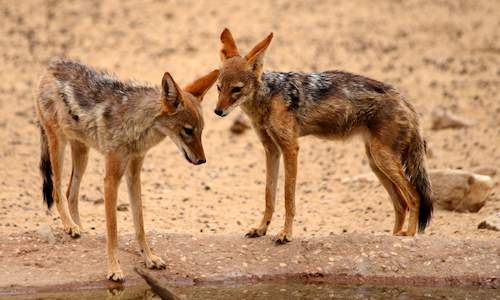
Black-backed jackals are remarkable for their adaptability and they adjust and survive in varied and even harsh environments. They are excep...
more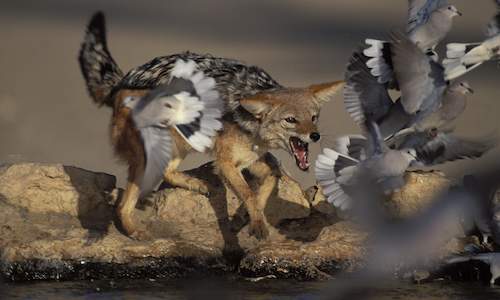
Food - Insects, rodents, small antelope and antelope lambs, birds, fruit, carrion...
more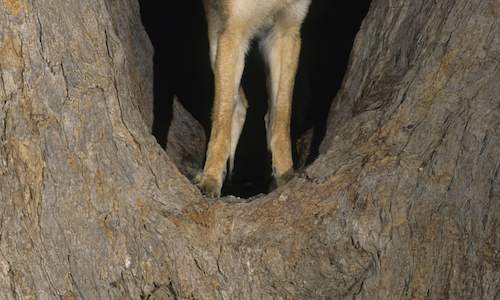
Being smaller carnivores, jackals will characteristically use elevated sites such as rocks or compacted vegetation to deposit their scat....
more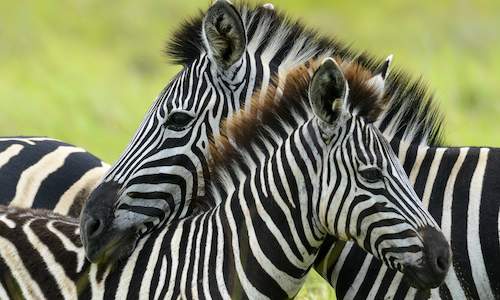
Learning about the mammals of South Africa is now so much easier for all South Africans - SouthAfrica.co.za is an excellent source of inform...
more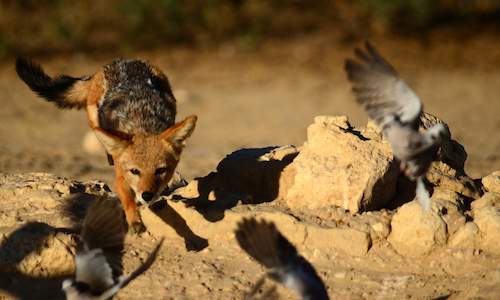
Jackals are extremely resourceful feeders. They are omnivores and will eat whatever is available even changing their menu seasonally....
more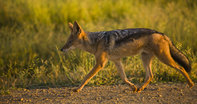
 Black-backed jackals are remarkable for their adaptability and they adjust and survive in varied and even harsh environments. They are excep...
Black-backed jackals are remarkable for their adaptability and they adjust and survive in varied and even harsh environments. They are excep... Food - Insects, rodents, small antelope and antelope lambs, birds, fruit, carrion...
Food - Insects, rodents, small antelope and antelope lambs, birds, fruit, carrion... Being smaller carnivores, jackals will characteristically use elevated sites such as rocks or compacted vegetation to deposit their scat....
Being smaller carnivores, jackals will characteristically use elevated sites such as rocks or compacted vegetation to deposit their scat.... Learning about the mammals of South Africa is now so much easier for all South Africans - SouthAfrica.co.za is an excellent source of inform...
Learning about the mammals of South Africa is now so much easier for all South Africans - SouthAfrica.co.za is an excellent source of inform... Jackals are extremely resourceful feeders. They are omnivores and will eat whatever is available even changing their menu seasonally....
Jackals are extremely resourceful feeders. They are omnivores and will eat whatever is available even changing their menu seasonally....